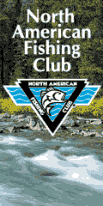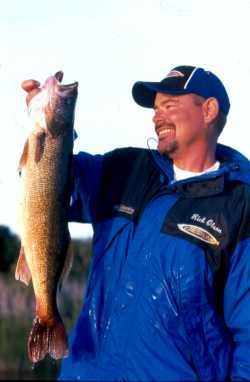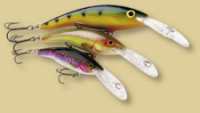





















Free 90 day Risk free trial offer click
here

|

Bridging the gap to reservoir
walleyes
By Rick Olsen
One of the keys to good walleye fishing, is to spend your time in areas
of high concentrations. It only stands to reason that a heavy concentration
of fish can greatly increase your chance of finding at least a few that
are active. Finding good concentrations of walleyes in big reservoirs,
come late fall, can be as simple as looking under the nearest bridge. Understanding
how and why bridges attract late season walleyes begins by taking a good
look at the forage base, and understanding how it reacts under given conditions.
Like always; If you can find the forage, you’ll find the walleyes.
 Author Rick Olsen hoists a fine reservoir walleye taken from
under a bridge
Author Rick Olsen hoists a fine reservoir walleye taken from
under a bridge
|
As the season progresses, walleyes will key on various food sources.
They’ll take advantage of peak situations, where bait is most plentiful,
and easiest to be had. By late summer, a lot of what they have been keying
on has been grazed down, and it becomes time to make a move. That next
move will often lead them up a creek, or creek arm, where they can gorge
themselves on the newest entries to the food chain; Young of the year white
bass, perch, and minnows. Creek arms serve as nurseries for all kinds of
bait fish, that can live and grow in the relative safety of the many shallow
bays and coves. They’ll call those areas home for most of the open water
season. |
However, big changes are in store that will force them to leave the
nest, and put them in a rather precarious position. By early fall, reservoirs
begin to be lowered to winter pool. Falling water levels will flush all
of that bait out of the shallows, and send them on a downstream migration,
and into harms way. As the bait makes it’s move, opportunistic walleyes
will set up in specific areas where they can cash in on some easy pickins’.
Those specific areas include bridges, which can play an important role
in late season walleye location.
Bridges come into play for a couple of reasons, including the fact
that they are usually located up creek arms, and are near areas that are
necked down. The fall draw down creates current, which is increased by
areas that are pinched off, or necked down. The result is a funnel effect,
where walleyes can wait and
ambush bait that is delivered directly to them, on a silver platter.
Walleyes instinctively know that current areas can provide some tremendous
feeding opportunities, and are drawn to them like a magnet. Any bridge
should be checked out, but one surrounded by deeper water has the most
potential to be aserious producer. A bridge up a creek arm, with some fifteen
to twenty feet of water nearby, would fall into the “serious producer”
category.
How you approach a bridge will depend on how much wind, or current,
you have to deal with. Calmer conditions are easy to deal with, and maneuvering
can be accomplished with an electric trolling motor. High winds and heavy
current can change things, and drastic measures may be in order, like dropping
the hook. Aheavy, twenty-eight pound Navy style anchor, can give you the
staying power you need to hold under the toughest conditions. The alternative
may be to throw in the towel, and what’s the fun in that?
 |
Top presentations for bridge bound walleyes include dragging bottom
bouncer and live bait combinations, casting with a jig tipped with a minnow
or crawler, or vertical jigging, depending on how deep and how
clear the water is that you happen to be working |
Casting crankbaits is another option, and can be especially effective if
you have some darker water up shallow. A bottom bouncer combined with a
plain snell and minnow, like a red tail chub, rates high on the list of
all time fall favorites, and can be worked in and around most of the structure
associated with bridges. A big chub can elicit a ferocious strike, and
from a fish that is normally thought of as finicky, or light biting. Bridge
pilings are obvious fish holding structures, and should be thoroughly worked.
Cast or drag a jig along side, behind, and in front of every piling. If
you’re jigging straight up and down, a simple lift and
drop is about all the action you’ll need to get a response. The not
so obvious includes a rip rap shoreline, that usually accompanies a bridge
embankment. Look for rip rap to be particularly productive early in the
morning, and late in the evening.

Rapala Tail Dancer
|
Try casting a crankbait, like the Normark Tail
Dancer, right up to the waters edge, and slowly work it back. The Tail
Dancer has a built in rattle that can suck walleyes in, especially in darker
water. A great cranking technique includes a stop and go retrieve, which
closely imitates the natural movements of real bait fish |
To accomplish the right action, cast the bait out, give the reel
a few cranks to get it to running depth, and then pull the bait with the
rod tip, followed by using the reel to take up the slack only. The result
is a flutter and stop action, that can really turn walleyes on. On your
retrieve, try to concentrate on what’s happening, and set the hook on anything
that feels out of the ordinary, including a vibration that has suddenly
stopped, or a line that has gone slack. Too often, that’s the only indication
you’ll get, and if you miss the bite, you can easily miss the fish. Even
with all those hooks, a walleye can inhale a crank bait and spit it out
before you even know what hit you. If you haven’t cashed in on the fall
bridge phenomenon yet, you might want to give it a serious try this season.
The fact is, it doesn’t last forever, and the best action will be over
before you know it.
Rick Olson

 
International
Fishing Banner Exchange
Walleyes Inc. website is maintained
by Randy
Tyler Fishing the In-Fisherman Professional Walleye Circuit, Masters
Walleye Circuit and the Team Walleye Circuit. All rights reserved.Copyright
1999/2001
Please visit these site sponsors
Daiichi/Tru-Turn Hooks,
Lindy
Little Joe,
R-A.M Mounting Systems,
Ranger
boats,
Mercury Marine, Bedford
Sales , Hamby's Beaching Bumpers,
Goldeneye
Marine products, Panther
Marine Products, Webfoots body
sock,
Bait Rigs Tackle
|





